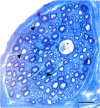Clinical features of muscle stiffness in 37 dogs with concurrent naturally occurring hypercortisolism
- PMID: 36798032
- PMCID: PMC10061197
- DOI: 10.1111/jvim.16620
Clinical features of muscle stiffness in 37 dogs with concurrent naturally occurring hypercortisolism
Abstract
Background: Severe muscle stiffness (SMS) in dogs with hypercortisolism (HC) is uncommon.
Objectives: To evaluate signalment, presentation, treatments, and long-term outcomes of dogs with concurrent HC and SMS.
Animals: Thirty-seven dogs.
Methods: Medical records of dogs with HC and concurrent SMS were recruited from 10 institutions. Clinical information, test results, therapeutic responses, and survival times were reviewed.
Results: All 37 dogs with HC and SMS had pituitary-dependent hypercortisolism (PDH); 36/37 weighed <20 kg. Signs and test results were typical of PDH aside from SMS, initially diagnosed in all 4 limbs in 9, pelvic limbs of 22, and thoracic limbs of 6 dogs. Hypercortisolism and SMS were diagnosed together in 3 dogs; HC 1-36 months before SMS in 23; SMS 1-12 months before HC in 11. Mitotane or trilostane, given to control HC in 36/37 dogs, improved or resolved HC signs in 28; SMS did not resolve, remaining static or worsening in 31/36 dogs, mildly improving in 5/19 dogs given additional therapies. Progression of SMS included additional limbs in 10 dogs and the masticatory muscles of 2. The median survival time from diagnosis of SMS was 965 days (range, 8-1188).
Conclusions and clinical importance: Concurrent SMS and HC is uncommon, possibly affecting only dogs with PDH. Development of SMS might occur before or after diagnosis of HC. Apart from SMS, the clinical picture and survival time of these dogs seem indistinguishable from those of dogs with HC in general. However, while muscle weakness usually resolves with HC treatment SMS does not.
Keywords: dive bomber sound; median survival time; myotonia; pituitary dependent hypercortisolism; rigidity; treatment.
© 2023 The Authors. Journal of Veterinary Internal Medicine published by Wiley Periodicals LLC. on behalf of the American College of Veterinary Internal Medicine.
Conflict of interest statement
Stefania Golinelli is the recipient of a PhD scholarship from Dechra Veterinary Products Ltd at the University of Bologna. Dechra Veterinary Products Ltd did not have any input in the design of the study, the analysis and the interpretation of data or in the writing of the manuscript. Other authors declare no conflict of interest.
Figures




Similar articles
-
Effect of pituitary-dependent hypercortisolism on the survival of dogs treated with radiotherapy for pituitary macroadenomas.J Vet Intern Med. 2023 Jul-Aug;37(4):1331-1340. doi: 10.1111/jvim.16724. Epub 2023 May 22. J Vet Intern Med. 2023. PMID: 37218395 Free PMC article.
-
Association between post-ACTH cortisol and trilostane dosage in dogs with pituitary-dependent hypercortisolism.Domest Anim Endocrinol. 2024 Oct;89:106871. doi: 10.1016/j.domaniend.2024.106871. Epub 2024 Jul 4. Domest Anim Endocrinol. 2024. PMID: 39032188
-
Effects of trilostane on the pituitary-adrenocortical and renin-aldosterone axis in dogs with pituitary-dependent hypercortisolism.Vet J. 2010 Jan;183(1):75-80. doi: 10.1016/j.tvjl.2008.10.007. Epub 2008 Nov 29. Vet J. 2010. PMID: 19042143
-
Treating canine Cushing's syndrome: Current options and future prospects.Vet J. 2018 Nov;241:42-51. doi: 10.1016/j.tvjl.2018.09.014. Epub 2018 Sep 27. Vet J. 2018. PMID: 30340659 Review.
-
Interpretation of laboratory tests for canine Cushing's syndrome.Top Companion Anim Med. 2011 May;26(2):98-108. doi: 10.1053/j.tcam.2011.03.001. Top Companion Anim Med. 2011. PMID: 21596349 Review.
Cited by
-
Cushing's Myopathy in Dogs: Prevalence, Clinical Abnormalities, and Response to Treatment.Animals (Basel). 2024 Oct 29;14(21):3109. doi: 10.3390/ani14213109. Animals (Basel). 2024. PMID: 39518832 Free PMC article.
-
Case Report: Suspected "stiff dog syndrome" in a Maltese dog.Front Vet Sci. 2025 Jun 13;12:1613131. doi: 10.3389/fvets.2025.1613131. eCollection 2025. Front Vet Sci. 2025. PMID: 40586031 Free PMC article.
-
Presumed acquired neuromyotonia of unknown cause in a cat with hyperthyroidism.JFMS Open Rep. 2024 Dec 7;10(2):20551169241297768. doi: 10.1177/20551169241297768. eCollection 2024 Jul-Dec. JFMS Open Rep. 2024. PMID: 39649332 Free PMC article.
-
Trismus due to myotonia associated with hyperadrenocorticism in a dog.J Vet Med Sci. 2023 Aug 1;85(8):876-879. doi: 10.1292/jvms.23-0103. Epub 2023 Jun 23. J Vet Med Sci. 2023. PMID: 37357395 Free PMC article.
References
-
- Behrend EN. Canine hyperadrenocorticism. In: Feldman EC, Nelson RW, Reusch CE, et al., eds. Canine and Feline Endocrinology. 4th ed. St. Louis, MO: Elsevier Saunders; 2015:377‐451.
-
- Griffiths IR, Duncan ID. Myotonia in the dog: a report of four cases. Vet Rec. 1973;93:184‐188. - PubMed
-
- Duncan ID, Griffiths IR, Nash AS. Myotonia in canine Cushing's disease. Vet Rec. 1977;100:30‐31. - PubMed
-
- Greene CE, Lorenz MD, Munnell JF, et al. Myopathy associated with hyperadrenocorticism in the dog. J Am Vet Med Assoc. 1979;174:1310‐1315. - PubMed
-
- Swinney GR, Foster SF, Church DB, et al. Myotonia associated with hyperadrenocorticism in two dogs. Aust Vet J. 1998;76:722‐724. - PubMed

